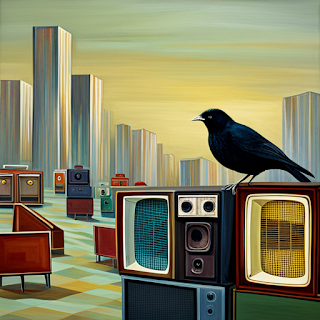Deleted Notes & Queries response: What is the single most effective thing I could do to reduce my carbon footprint?
The following was posted in the comments section of Notes & Queries, on The Guardian website, on the 1st May, 2022. It was promptly deleted by the jannies for infringing upon the community standards, as I assumed it would be.
It is not that The Guardian can't handle the half-truth; it's just that this is the opposite half.
If you would like to know more about Rambengun politics, wait 12 months and I will happily sell you an entire novel's worth.
What is the single most effective thing I could do to reduce my carbon footprint?
I met Dr Marcus Tuta in 2019. At this time he was the long-serving GP for the Rambengun ex-pat community that had put down roots in Hammersmith, in West London, and had remained there for many decades.
Before I continue, I would like to make it clear that I will not be discussing Tuta's disappearance, nor will I be speculating on what may have become of the man. I am not privy to the details of what went on exactly, and do not think that they are particularly relevant to the question at hand. My friend, John Court, at The Fairlead would know more.Tuta's surgery amounted to a couple of rooms occupying one corner of the community centre that exclusively served the local Rambengun population. The walls of the open waiting area, which was fenced off with a right-angled line of plastic chairs, and often strewn with children's toys, were decorated with a 90 degree mural, depicting a procession of young boys and girls, arranged in diminishing order of height, gaily descending a steep mountain slope. Each child was leading a small black cloud, that hovered above their heads on the end of a length of string, like an overcast balloon or some kind of strange pet.
I asked him who had painted it, as it was an unusual style that I had not seen before, even in African art. Tuta replied that he did not know much about the origin of the painting, other than it had likely been commissioned by his predecessor, and that he would have liked to have gotten rid of it, and would have done so if the community had not taken it to heart, and ascribed to it a different meaning to the one that was originally intended.
“The children, particularly those with long-term conditions, see it as a symbol of gaining mastery over their illnesses,” he explained. “I expect the parents know the true meaning but say nothing.”
My enquiry as to the true meaning drew a laboured sigh from the Doctor. He shuffled into his office, his flip-flops snapping against his cracked heels. Reaching to the shelf above his desk, he took down a hardback book.
“This was written by my colleague Gabre Yero,” he said, as he handed it to me. “He is the community pharmacist here in London. He also sits on the pharmacy council for Rambengu. His speciality is children's medicine.”
The book had a rather bland cover: A poorly-composed photograph of arid steppe-land, overshadowed by a dark sky that was crowded with smouldering thunderheads. I couldn't read a single word the text. Tuta translated the title to: Born Under Another Man's Cloud.
“The area around the main city of Cololedo, in the mountains, is where most of the profitable mines are,” he expanded. “Very little of the wealth they produce trickles down to the poor from the purses of the wealthy owners.”
“That would be this community in London,” I said. “I am right to say that your community is built on mining wealth?”
Tuta seemed to acknowledge my point while not directly responding to it.
“With the mine spoil it is a different matter,” he said. “That does not so much trickle down as arrive in the shed slums, and the lives of the poor, as a great torrent. Air pollution used to be terrible in the city. The government was under pressure at home, and internationally, to reduce the carbon footprint. The solution they went with is crude and inhumane; it was actually first used in the country during the colonial era, by the British Empire in the 1800s, before falling out of favour. It has been brought back, but it does not solve the problem. It only harms the vulnerable in society and burdens our neighbours.
“The process is called leashing. It involves drawing air pollutants to a pied piper: The destitute in Rambengun society are paid a small sum to ingest a compound of powdered metals and minerals. These substances react with the human body which becomes a magnet, attracting harmful particles down from the atmosphere. After a while they form a poisonous cloud around the individual who must then walk along a certain road, that is otherwise only used by the military, to the border with Boartaygeh. By this time the compound has worn off and the pollutants dissipate and form lowland smogs. Obviously harm is done to the person who walks inside the cloud and breathes in the toxins. The build up of heavy metals in the body is also concerning. I have raised the issue. Yero has too. We have been told that we need to take a more utilitarian outlook when considering the situation. The media, even here in the west, have ignored or censored our attempts to communicate the problem.”
He indicated the painting.
“So that is what the children here are doing: Walking in single file into a lifetime of poor health with smiles on their faces. I know it. The parents who sit here in the waiting room know it. Your government, who benefit greatly from our mining industry know it. Now you know it too.”
I hope this is of help.
.jpg)



Comments
Post a Comment